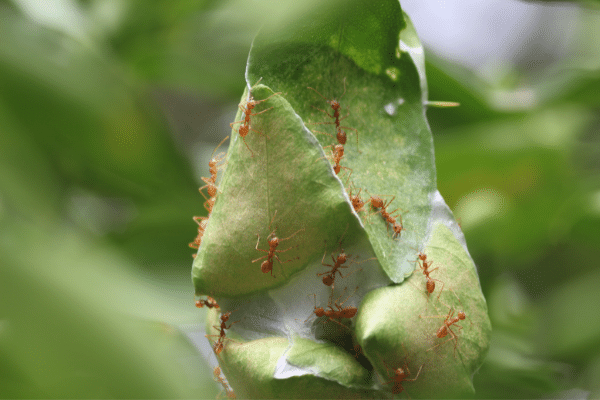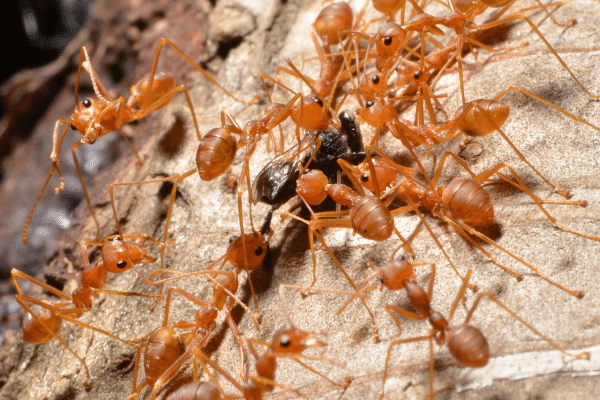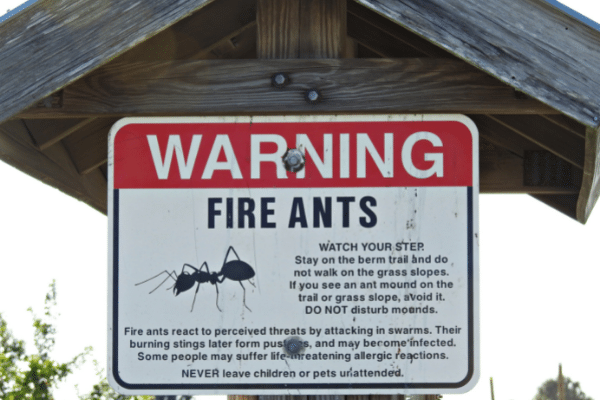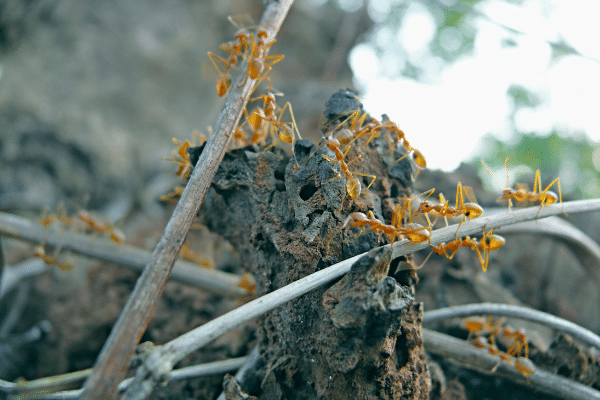- Home
- Get Rid Of Ants
- What Do Fire Ants Eat
What Do Fire Ants Eat
This post may contain affiliate links so I earn a commission.
What do fire ants eat - and why does this
matter?
Finding out what fire ants like to feed on is important if you want to control these frustrating (and potentially dangerous) lawn pests.
These aggressive ants are found in the southern portions of the United States.
They reside in colonies and eat plants, insects, and certain types of meat - meaning they are omnivores.
If you’re trying to deal with fire ants, knowing what they eat is a first (and instrumental) step in getting rid of them.
Let’s dive in.
What Are Fire Ants?
Also known as red imported fire ants, fire ants, or Solenopsis invicta, are some of the most threatening of all ant species.
Not only do they reproduce rapidly and have the ability to cause extensive damage, but they are also far more aggressive than any other ant species.

These ants build nests outside, creating their
homes in mounds of soil that are about the size of dinner plates.
They live several feet beneath these nests in elaborate and interconnected subterranean tunnels.
Fire ants can be seriously aggravating for homeowners to deal with.
They injure millions of people each year with their painful stings - stings that for some people who suffer from allergic reactions, can be life-threatening.
What Do Fire Ants Eat?
What do fire ants eat?
Well, they'll eat just about anything!
They are omnivores that subsist on both animals and plants.
They eat carbohydrates, fats, and proteins of all kinds.
Some fire ants prefer to feed on insects while others like plants.
For the most part, fire ants prefer oily foods as well as rich carbohydrates and proteins like honey and peanut butter.
Not all fire ant colony members eat the same types of foods, either.

For example, worker ants cannot digest solid
food particles so they eat mostly liquids.
It is only the final developmental stage of the fire ant larvae, known as the fourth instar, that has the ability to convert solid food particles into liquids.
They then feed these liquids to other colony members.
Some fire ants have a penchant for a specific type of food, something that can spell disaster for agricultural producers in particular.
For example, fire ants can be held responsible for damaging millions of dollars worth of agricultural crops like soybeans, corn, sorghum, and even citrus fruits.
There are other fire ants that feed on invertebrates like spiders and scorpions.
They’ll even go after carcasses of vertebrates like reptiles and mammals - since the animals are already incapacitated, they’re an easy target for fire ants.
The fire ants are able to glean a great deal of protein from these sorts of food sources, too.
When it comes to killing live prey, fire ants are efficient killers.
They have strong mandibles (or jaws) that they use to bite and immobilize their prey.

Their venomous stingers allow them to inject toxic venom into their prey, making it easy for them to paralyze and kill animals that are much larger than they are.
Once the prey is dead, the fire ants will dismantle it into smaller pieces to bring it back to the colony.
Let’s not forget sugary foods, menu items that are classic choices for ants of all kinds (and not just fire ants).
They love the same sweet foods we do like sugar, honey, molasses, and syrup, but also appreciate the honeydew produced as secretions by insects like mealybugs, whiteflies, and scale insects.
Plant nectar is another source of nutrition for fire ants!
How Do Fire Ants Find Food?
It is important to understand how and where fire ants find their food so that you can take specific measures to avoid them.
When fire ants are hungry, they send out a single worker fire ant to find some food.
Once he locates a meal, he generates a pheromone that he uses to create a marked trail around it.
This pheromone trail alerts the rest of the colony that there is food, with the other colony members quickly picking up the scent for their next meal.
What Are Fire Ants Attracted To?
As you might expect by reading the information above, fire ants can be attracted to just about any type of food, from sweet and sugary to meaty and greasy.
They’re also attracted to plants when they realize that there is honeydew from sucking insects there.
In fact, that’s a major problem that many people have when dealing with a pest infestation in the garden - fire ants love the insects that are producing the honeydew and protect them by guarding against natural enemies like predators and parasites.

Fire ants also eat ill or unhealthy pests,
which might sound helpful to you, as the gardener - however, when they get rid
of the unhealthy specimens, it allows the stronger ones to flourish.
This can lead to an explosive growth of garden pests like aphids, whiteflies, and scale insects as only the strongest individuals survive.
One of the best ways to control fire ants is to think carefully about what sources of food might be attracting them to your property.
Once you know what’s drawing them in, whether it’s the dog food bowls in your foyer or the sugary soda spilled on your back deck, you will be able to come up with a more effective pest management plan.
Since fire ants have such diverse eating habits, knowing exactly what’s attracting your specific type of fire ants will be helpful in finding the right bait or other ant control product.
What Do Fire Ants Eat - Getting Rid of Fire Ants
Fire ants are notorious for their painful bites and their stubborn, tenacious nature.
If you want to avoid attracting them to your yard or home, there are a few things you should know.
The most important?
Understanding what fire ants eat.
Knowing which foods attract a hungry fire ant is essential if you want to prevent them from invading your home and garden.
Follow the advice above to limit the likelihood of enticing these creatures to your property - and contact a pest control professional if you find that your infestation has gotten out of hand.



